10 April 2005
Belize, Mexico and the Dry Tortugas N16.30.472 W 88.21.867
Heading Home
Belize is a most curious place. The country is the size of New Hampshire with a coastline that extends for approximately 200 miles. The major exports include bananas and mahogany chips (since little is left of the trees) and the major industry is tourism. Although the waters are inviting and the marine life still abundant the geography does not allow for easy access.
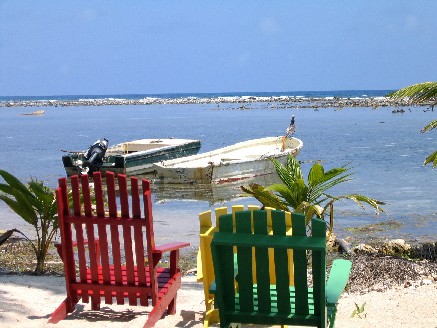 The barrier reef lies anywhere from ten to twenty miles from the mainland and the islands along the reef are too small to support the infrastructure for major hotels. Yet this is where the beauty of the country lies. Beyond the reefs are the atolls even more interesting than the barrier reef and even more handicapped by the remoteness of their location. Today's solution is the live aboard dive boats that are in fact floating hotels that anchor near the good dive sites, This is an expensive solution and only appeals to the avid diver. The cruise ships that visit Belize City must anchor off the city due to the shallow water that surrounds the mainland. Guest are ferried about two miles to the city docks and of course they returned before evening. During the day, these mammoth floating cities are surrounded by fast launches ready to take people on day outings to the city or to locations for snorkeling or diving. The barrier reef lies anywhere from ten to twenty miles from the mainland and the islands along the reef are too small to support the infrastructure for major hotels. Yet this is where the beauty of the country lies. Beyond the reefs are the atolls even more interesting than the barrier reef and even more handicapped by the remoteness of their location. Today's solution is the live aboard dive boats that are in fact floating hotels that anchor near the good dive sites, This is an expensive solution and only appeals to the avid diver. The cruise ships that visit Belize City must anchor off the city due to the shallow water that surrounds the mainland. Guest are ferried about two miles to the city docks and of course they returned before evening. During the day, these mammoth floating cities are surrounded by fast launches ready to take people on day outings to the city or to locations for snorkeling or diving.
Without deep water and good harbors, tourism is also hampered by the occasional hurricane and in fact the capital of Belize has been move to Belmopan some 60 miles from the shore in order to avoid future hurricane damage to government facilities and to enable the government to continue to operate under hurricane conditions.
The population of Belize is approximately 290,000 which if compared to New Hampshire's 1,300,000 you can see that the population density has plenty of room to expand. I might add that one informed source told me that there were 200,000 Belizeans living in the US. The cruising guides tell you that Belize City should be avoid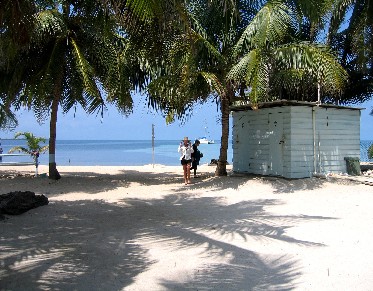 ed at night and after a walk or taxi ride through the city you can see that unemployment and poverty are very high among the general population. On the other hand the people we encountered were friendly and helpful and ambitious. English is the primary language while there is a native language of pidgin English that separates the "Belongers" from the tourists. Most every taxi driver and even panhandlers on the street have been to the US, so go figure. ed at night and after a walk or taxi ride through the city you can see that unemployment and poverty are very high among the general population. On the other hand the people we encountered were friendly and helpful and ambitious. English is the primary language while there is a native language of pidgin English that separates the "Belongers" from the tourists. Most every taxi driver and even panhandlers on the street have been to the US, so go figure.
The government is promulgating regulations to protect its natural resource by declaring large tracts of the atolls as natural parks and by charging fees to visit. This is a reasonable approach but today the regulations are unclear and recent increases in the fees are driving away visitors. In certain areas restrictions have also been put on spear fishing. Over fishing is a much discussed problem but it certainly doesn't come from the few cruisers that are adept enough to spear a fish or two.
Despite these few shortcomings it is a great place for the cruising community especially if you are into snorkeling and diving. Try and come when you can snorkel with the whale sharks. These thirty footers are the largest fish in the ocean and they arrive around Easter when they feed off the fish eggs spawned in the area. Snorkeling and diving expeditions are run out of Placentia and it is to our regret that we were unable to stay for what must be a most memorable event.
After our guest departed we headed for Isla Mujeres a small island off the Yucatan and a quick 15 minute ferry ride form Cancun. During this two day sail Shiraz was pushed by a two knot current and 22 knots of winds. There were periods when we sustained 11 knots of boat speed for an hour or more. But Mother Nature has a way of dealing with people who are too greedy. As we rounded the corner to enter the harbor at Isla Mujeres our auto pilot started to screech and the linear drive was shot. Now the linear drive has been in the boat since 1993 and I have no records that it was ever serviced but in the back of your mind you have got to wonder if that lust for speed didn't play a role in its demise.
.
Our son Brad and his fr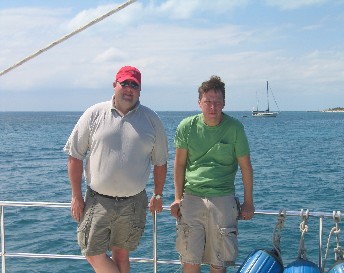 iend Mark Bruce traveled to Isla Mujeres to help us sail the boat back to the US. What a break since our autopilot was out. As luck would have it their arrival was accompanied by the worst northerly winds so far this season. This nixed the trip back to the US since at the height of the storm the waves were 15 to 20 feet in the vicinity of the Dry Tortugas. The front brought winds to the anchorage in the 25 to 30 knot range and the anchorage at Isla is noted for poor holding. About half the boats in the anchorage moved to the inner lagoon and the rest drug. Dragging anchor consist of a slow pull (or worse a fast break) with each wave that moves the boat an inch at a time until you notice that you are uncomfortably close to the shore or a neighboring boat. Then there are times when boats dragging sets the radio ablaze with chatter. When the weather is bad we leave the radio on and most of the time take our handheld GPS to bed with the "drag" alarm on. One morning around 5:30 we were awaken by a ladies voice on the radio nearly shouting "Cat dragging, cat dragging, watch out!" Well there were only about three catamarans in the anchorage and Shiraz was one. I'm not sure how we both got out of bed and in the cockpit ready to start the engines before you could count to three. Fortunately for us, it wasn't Shiraz but another catamaran whizzing by. iend Mark Bruce traveled to Isla Mujeres to help us sail the boat back to the US. What a break since our autopilot was out. As luck would have it their arrival was accompanied by the worst northerly winds so far this season. This nixed the trip back to the US since at the height of the storm the waves were 15 to 20 feet in the vicinity of the Dry Tortugas. The front brought winds to the anchorage in the 25 to 30 knot range and the anchorage at Isla is noted for poor holding. About half the boats in the anchorage moved to the inner lagoon and the rest drug. Dragging anchor consist of a slow pull (or worse a fast break) with each wave that moves the boat an inch at a time until you notice that you are uncomfortably close to the shore or a neighboring boat. Then there are times when boats dragging sets the radio ablaze with chatter. When the weather is bad we leave the radio on and most of the time take our handheld GPS to bed with the "drag" alarm on. One morning around 5:30 we were awaken by a ladies voice on the radio nearly shouting "Cat dragging, cat dragging, watch out!" Well there were only about three catamarans in the anchorage and Shiraz was one. I'm not sure how we both got out of bed and in the cockpit ready to start the engines before you could count to three. Fortunately for us, it wasn't Shiraz but another catamaran whizzing by.
The winds slowly dissipated over the next three days so we were able to salvage a day of snorkeling, a day sailing and a day of diving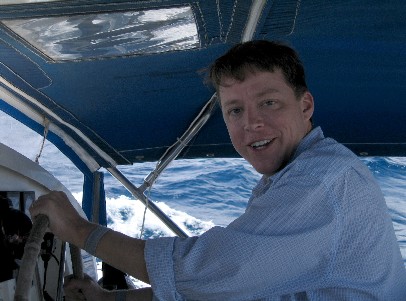 with Brad and Mark and they had the opportunity to learn a little about life on the boat and what makes things tick, like water conservation. Anyway we had a great time. The first of our two tank dives took us to a 130 foot wreck in 83 feet of water and with a strong current. The ship was now broken in two from a previous hurricane and the dive master led us in and out of the rusting hull among schools of Bermuda chub, yellow tail snapper and a wide variety of other fish. with Brad and Mark and they had the opportunity to learn a little about life on the boat and what makes things tick, like water conservation. Anyway we had a great time. The first of our two tank dives took us to a 130 foot wreck in 83 feet of water and with a strong current. The ship was now broken in two from a previous hurricane and the dive master led us in and out of the rusting hull among schools of Bermuda chub, yellow tail snapper and a wide variety of other fish.
Although the weather for us was partly overcast for Brad and Mark it was partly sunny when comparing it to a March day in Indianapolis. Okay, except for the day that they went to shore and rented a golf cart!
We made the trip from Isla Mujeres to the Dry Tortugas with Crowe's Nest crewed by Tom and Ingrid. Ingrid flew in the night before from Paris where she works as a biologists at the Institute Curie . Since we were hand steering we took one hour shifts for this 50 hour passage. It was nice to have company on the passage especially when we had a two hour lightening display. We were happy to see the light house on Loggerhead Key knowing that an anchorage was now nearby. The most difficult part of a passage is the patience required from that first sighting of land until you are anchored. The sight through the binoculars tempt you to turn on the engines and make way as fast as possible.
Da Plane, Da Plane
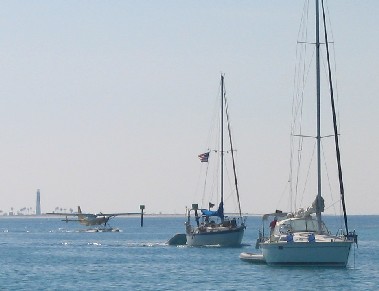
We thought of this little piece of trivia from Fantasy Island as we set anchored off of Garden Key in the Dry Tortugas. Several times a day a sleek sea plane would land and take off within 200 yards of Shiraz bringing tourists from Key West to this National Park the home of Fort Jefferson. We didn't find Tutu or Ricardo Montalban on the island but rather one of the early monuments to the squandering of Federal funds. The Fort was built during the 1830's to protect the Gulf of Mexico from some imagined invasion. The island it was built upon had no natural port and no water. After hauling 13 million bricks and all the necessary cement and lumber and steel the completion was abandoned when the shifting sands and tireless sea undertook the deterioration of the structure. The fort served as a prison during the Civil War and Dr. Mudd, who became famous as the physician who treated John Wilkes Booth, was incarcerated there for four years before he was pardoned by President Johnson. In 1936 the Fort and the surrounding keys became a National Historic Landmark and eventually a National Park.
The anchorage gave us a place to rest up before the last leg of this passage but the holding was poor and our night of rest was interrupted by high winds and four boats dragging and of course all this started at about 0230.
Back Next
|